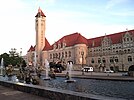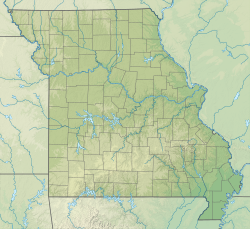
A | B | C | D | E | F | G | H | CH | I | J | K | L | M | N | O | P | Q | R | S | T | U | V | W | X | Y | Z | 0 | 1 | 2 | 3 | 4 | 5 | 6 | 7 | 8 | 9
St. Louis | |
|---|---|
|
| |
| Nickname(s): | |
 Interactive map of St. Louis | |
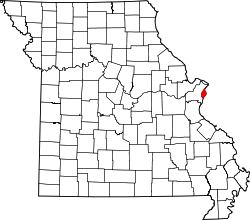 Saint Louis in Missouri | |
| Coordinates: 38°37′38″N 90°11′52″W / 38.62722°N 90.19778°W | |
| Country | United States |
| State | Missouri |
| CSA | St. Louis–St. Charles–Farmington, MO–IL |
| Metro | St. Louis, MO-IL |
| Founded | February 14, 1764 |
| Incorporated | 1822 |
| Named for | Louis IX of France |
| Government | |
| • Type | Mayor–council |
| • Body | Board of Aldermen |
| • Mayor | Tishaura Jones (D) |
| • President, Board of Aldermen | Megan Green (D) |
| • Treasurer | Adam Layne |
| • Comptroller | Darlene Green (D) |
| • Congressional representative | Cori Bush (D) |
| Area | |
| • Independent city | 66.17 sq mi (171.39 km2) |
| • Land | 61.72 sq mi (159.85 km2) |
| • Water | 4.45 sq mi (11.53 km2) |
| • Urban | 910.4 sq mi (2,357.8 km2) |
| • Metro | 8,458 sq mi (21,910 km2) |
| Elevation | 466 ft (142 m) |
| Highest elevation | 614 ft (187 m) |
| Population | |
| • Independent city | 301,578 |
| • Estimate (2021)[9] | 293,310 |
| • Rank | US: 70th Midwest: 13th Missouri: 2nd |
| • Density | 4,886.23/sq mi (1,886.59/km2) |
| • Urban | 2,156,323 (US: 22nd) |
| • Urban density | 2,368.6/sq mi (914.5/km2) |
| • Metro | 2,809,299 (US: 21st) |
| • CSA | 2,914,230 (US: 20th) |
| Demonym(s) | St. Louisan; Saint Louisan |
| GDP | |
| • Greater St. Louis | $209.9 billion (2022) |
| Time zone | UTC−6 (CST) |
| • Summer (DST) | UTC−5 (CDT) |
| ZIP Codes | List |
| Area code | 314/557 |
| FIPS code | 29-65000 |
| Website | stlouis-mo |
St. Louis (/seɪnt ˈluːɪs, sənt-/ saynt LOO-iss, sənt-)[11] is an independent city in the U.S. state of Missouri. It is located near the confluence of the Mississippi and the Missouri rivers. In 2020, the city proper had a population of 301,578,[8] while its bi-state metropolitan area, which extends into Illinois, had an estimated population of over 2.8 million. It is the largest metropolitan area in Missouri and the second largest in Illinois. The city's combined statistical area (CSA) is the 20th largest in the United States.[12]
The land that is now St. Louis had been occupied by Native American cultures for thousands of years before European settlement. The city was founded on February 14, 1764, by French fur traders Gilbert Antoine de St. Maxent, Pierre Laclède and Auguste Chouteau.[13] They named it for king Louis IX of France, and it quickly became the regional center of the French Illinois Country. In 1804, the United States acquired St. Louis as part of the Louisiana Purchase. In the 19th century, St. Louis developed as a major port on the Mississippi River; from 1870 until the 1920 census, it was the fourth-largest city in the country. It separated from St. Louis County in 1877, becoming an independent city and limiting its political boundaries. In 1904, it hosted the Louisiana Purchase Exposition, also known as the St. Louis World's Fair, and the Summer Olympics.[14][15]
St. Louis is designated as one of 173 global cities by the Globalization and World Cities Research Network.[16] The GDP of Greater St. Louis was $209.9 billion in 2022.[17] St. Louis has a diverse economy with strengths in the service, manufacturing, trade, transportation, and aviation industries.[18] It is home to fifteen Fortune 1000 companies, seven of which are also Fortune 500 companies.[19] Federal agencies headquartered in the city or with significant operations there include the Federal Reserve Bank of St. Louis, the U.S. Department of Agriculture, and the National Geospatial-Intelligence Agency.
Major research universities in Greater St. Louis include Washington University in St. Louis, Saint Louis University, and the University of Missouri–St. Louis. The Washington University Medical Center in the Central West End neighborhood hosts an agglomeration of medical and pharmaceutical institutions, including Barnes-Jewish Hospital.
St. Louis has four professional sports teams: the St. Louis Cardinals of Major League Baseball, the St. Louis Blues of the National Hockey League, St. Louis City SC of Major League Soccer, and the St. Louis BattleHawks of the United Football League. Among the city's notable attractions are the 630-foot (192 m) Gateway Arch in Downtown St. Louis, the St. Louis Zoo, the Missouri Botanical Garden, the St. Louis Art Museum, and Bellefontaine Cemetery and Arboretum.[20][21][22]
History
Mississippian culture and European exploration
Kingdom of France 1690s–1763
Kingdom of Spain 1763–1800
French First Republic 1800–1803
United States 1803–present
The area that would become St. Louis was a center of the Native American Mississippian culture, which built numerous temple and residential earthwork mounds on both sides of the Mississippi River. Their major regional center was at Cahokia Mounds, active from 900 to 1500. Due to numerous major earthworks within St. Louis boundaries, the city was nicknamed as the "Mound City". These mounds were mostly demolished during the city's development. Historic Native American tribes in the area encountered by early Europeans included the Siouan-speaking Osage people, whose territory extended west, and the Illiniwek.
European exploration of the area was first recorded in 1673, when French explorers Louis Jolliet and Jacques Marquette traveled through the Mississippi River valley. Five years later, La Salle claimed the region for France as part of La Louisiane, also known as Louisiana.
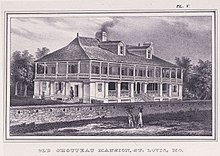
The earliest European settlements in the Illinois Country (also known as Upper Louisiana) were built by the French during the 1690s and early 1700s at Cahokia, Kaskaskia, and Fort de Chartres. Migrants from the French villages on the east side of the Mississippi River, such as Kaskaskia, also founded Ste. Genevieve in the 1730s.
In 1764, after France lost the Seven Years' War, Pierre Laclède and his stepson Auguste Chouteau founded what was to become the city of St. Louis.[23] (French lands east of the Mississippi had been ceded to Great Britain and the lands west of the Mississippi to Spain; Catholic France and Spain were 18th-century allies. Louis XV of France and Charles III of Spain were cousins, both from the House of Bourbon.[24][circular reference]) The French families built the city's economy on the fur trade with the Osage, as well as with more distant tribes along the Missouri River. The Chouteau brothers gained a monopoly from Spain on the fur trade with Santa Fe. French colonists used African slaves as domestic servants and workers in the city.
During the negotiations for the 1763 Treaty of Paris, French negotiators agreed to transfer France's colonial territories west of the Mississippi and Missouri rivers to New Spain to compensate for Spanish territorial losses during the war. These areas remained under Spanish control until 1803, when they were transferred to the French First Republic. During the American Revolutionary War, St. Louis was unsuccessfully attacked by British-allied Native Americans in the 1780 Battle of St. Louis.[25]
City founding
The founding of St. Louis was preceded by a trading business between Gilbert Antoine de St. Maxent and Pierre Laclède (Liguest) in the fall of 1763. St. Maxent invested in a Mississippi River expedition led by Laclède, who searched for a location to base the company's fur trading operations. Though Ste. Genevieve was already established as a trading center, he sought a place less prone to flooding. He found an elevated area overlooking the flood plain of the Mississippi River, not far south from its confluence with the Missouri and Illinois rivers. In addition to having an advantageous natural drainage system, there were nearby forested areas to supply timber and grasslands which could easily be converted for agricultural purposes. This place, declared Laclède, "might become, hereafter, one of the finest cities in America." He dispatched his 14-year-old stepson, Auguste Chouteau, to the site, with the support of 30 settlers in February 1764.[26]
Laclède arrived at the future town site two months later and produced a plan for St. Louis based on the New Orleans street plan. The default block size was 240 by 300 feet, with just three long avenues running parallel to the west bank of the Mississippi. He established a public corridor of 300 feet fronting the river, but later this area was released for private development.[26]
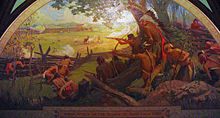
For the first few years of St. Louis's existence, the city was not recognized by any of the governments. Although the settlement was thought to be under the control of the Spanish government, no one asserted any authority over it, and thus St. Louis had no local government. This vacuum led Laclède to assume civil control, and all problems were disposed in public settings, such as communal meetings. In addition, Laclède granted new settlers lots in town and the surrounding countryside. In hindsight, many of these original settlers thought of these first few years as "the golden age of St. Louis".[27] In 1763, the Native Americans in the region around St. Louis began expressing dissatisfaction with the victorious British, objecting to their refusal to continue to the French tradition of supplying gifts to Natives. Odawa chieftain Pontiac began forming a pan-tribal alliance to counter British control over the region, but received little support from the indigenous residents of St. Louis. By 1765, the city began receiving visits from representatives of the British, French, and Spanish governments.
St. Louis was transferred to the French First Republic in 1800 (although all of the colonial lands continued to be administered by Spanish officials), then sold by the French to the U.S. in 1803 as part of the Louisiana Purchase. St. Louis became the capital of, and gateway to, the new territory. Shortly after the official transfer of authority was made, the Lewis and Clark Expedition was commissioned by President Thomas Jefferson. The expedition departed from St. Louis in May 1804 along the Missouri River to explore the vast territory. There were hopes of finding a water route to the Pacific Ocean, but the party had to go overland in the Upper West. They reached the Pacific Ocean via the Columbia River in summer 1805. They returned, reaching St. Louis on September 23, 1806. Both Lewis and Clark lived in St. Louis after the expedition. Many other explorers, settlers, and trappers (such as Ashley's Hundred) would later take a similar route to the West.
19th century
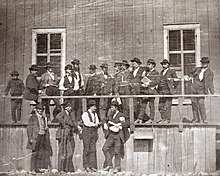
The city elected its first municipal legislators (called trustees) in 1808. Steamboats first arrived in St. Louis in 1817, improving connections with New Orleans and eastern markets. Missouri was admitted as a state in 1821. St. Louis was incorporated as a city in 1822, and continued to develop largely due to its busy port and trade connections.
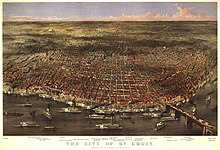

Immigrants from Ireland and Germany arrived in St. Louis in significant numbers starting in the 1840s, and the population of St. Louis grew from less than 20,000 inhabitants in 1840, to 77,860 in 1850, to more than 160,000 by 1860. By the mid-1800s, St. Louis had a greater population than New Orleans.
Settled by many Southerners in a slave state, the city was split in political sympathies and became polarized during the American Civil War. In 1861, 28 civilians were killed in a clash with Union troops. The war hurt St. Louis economically, due to the Union blockade of river traffic to the south on the Mississippi River. The St. Louis Arsenal constructed ironclads for the Union Navy.
Slaves worked in many jobs on the waterfront as well as on the riverboats. Given the city's location close to the free state of Illinois and others, some slaves escaped to freedom. Others, especially women with children, sued in court in freedom suits, and several prominent local attorneys aided slaves in these suits. About half the slaves achieved freedom in hundreds of suits before the American Civil War. The printing press of abolitionist Elijah Parish Lovejoy was destroyed for the third time by townsfolk. He was murdered the next year in nearby Alton, Illinois.
After the war, St. Louis profited via trade with the West, aided by the 1874 completion of the Eads Bridge, named for its design engineer. Industrial developments on both banks of the river were linked by the bridge, the second in the Midwest over the Mississippi River after the Hennepin Avenue Bridge in Minneapolis. The bridge connects St. Louis, Missouri to East St. Louis, Illinois. The Eads Bridge became a symbolic image of the city of St. Louis, from the time of its erection until 1965 when the Gateway Arch Bridge was constructed. The bridge crosses the St. Louis riverfront between Laclede's Landing, to the north, and the grounds of the Gateway Arch, to the south. Today the road deck has been restored, allowing vehicular and pedestrian traffic to cross the river. The St. Louis MetroLink light rail system has used the rail deck since 1993. An estimated 8,500 vehicles pass through it daily.
On August 22, 1876, the city of St. Louis voted to secede from St. Louis County and become an independent city, and, following a recount of the votes in November, officially did so in March 1877.[28] 1877 was a year of significant upheaval for the city when a general strike occurred there, in a fight for the eight-hour day and the banning of child labor.[29][page needed]
Industrial production continued to increase during the late 19th century. Major corporations such as the Anheuser-Busch brewery, Ralston Purina company and Desloge Consolidated Lead Company were established at St. Louis which was also home to several brass era automobile companies, including the Success Automobile Manufacturing Company;[30] St. Louis is the site of the Wainwright Building, a skyscraper designed in 1892 by architect Louis Sullivan.
20th century
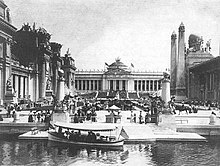
In 1900, the entire streetcar system was shut down by a several months-long strike, with significant unrest occurring in the city & violence against the striking workers.[31]
In 1904, the city hosted the World's Fair and the Olympics, becoming the first non-European city to host the games.[32] The formal name for the 1904 World's Fair was the Louisiana Purchase Exposition. Permanent facilities and structures remaining from the fair are located in Forest Park, and other notable structures within the park's boundaries include the St. Louis Art Museum, the St. Louis Zoo and the Missouri History Museum, as well as Tower Grove Park and the Botanical Gardens.
After the Civil War, social and racial discrimination in housing and employment were common in St. Louis. In 1916, during the Jim Crow Era, St. Louis passed a residential segregation ordinance[33] saying that if 75% of the residents of a neighborhood were of a certain race, no one from a different race was allowed to move in.[34] That ordinance was struck down in a court challenge, by the NAACP,[35] after which racial covenants were used to prevent the sale of houses in certain neighborhoods to "persons not of Caucasian race".[clarification needed] Again, St. Louisans offered a lawsuit in challenge, and such covenants were ruled unconstitutional by the U.S. Supreme Court in 1948 in Shelley v. Kraemer.[36]
In 1926, Douglass University, a historically black university was founded by B. F. Bowles in St. Louis, and at the time no other college in St. Louis County admitted black students.[37]
In the first half of the 20th century, St. Louis was a destination in the Great Migration of African Americans from the rural South seeking better opportunities.[citation needed] During World War II, the NAACP campaigned to integrate war factories. In 1964, civil rights activists protested at the construction of the Gateway Arch to publicize their effort to gain entry for African Americans into the skilled trade unions, where they were underrepresented. The Department of Justice filed the first suit against the unions under the Civil Rights Act of 1964.[citation needed]
Between 1900 and 1929, St. Louis, had about 220 automakers, close to 10 percent of all American carmakers, about half of which built cars exclusively in St. Louis. Notable names include Dorris, Gardner and Moon.[38]
In the first part of the century, St. Louis had some of the worst air pollution in the United States. In April 1940, the city banned the use of soft coal mined in nearby states. The city hired inspectors to ensure that only anthracite was burned. By 1946, the city had reduced air pollution by about 75%.[39]

De jure educational segregation continued into the 1950s, and de facto segregation continued into the 1970s, leading to a court challenge and interdistrict desegregation agreement. Students have been bused mostly from the city to county school districts to have opportunities for integrated classes, although the city has created magnet schools to attract students.[40]
St. Louis, like many Midwestern cities, expanded in the early 20th century due to industrialization, which provided jobs to new generations of immigrants and migrants from the South. It reached its peak population of 856,796 at the 1950 census.[41] Suburbanization from the 1950s through the 1990s dramatically reduced the city's population, as did restructuring of industry and loss of jobs.[citation needed] The effects of suburbanization were exacerbated by the small geographical size of St. Louis due to its earlier decision to become an independent city, and it lost much of its tax base. During the 19th and 20th century, most major cities aggressively annexed surrounding areas as residential development occurred away from the central city; however, St. Louis was unable to do so.[citation needed]
Several urban renewal projects were built in the 1950s, as the city worked to replace old and substandard housing. Some of these were poorly designed and resulted in problems. One prominent example, Pruitt–Igoe, became a symbol of failure in public housing, and was torn down less than two decades after it was built.
Since the 1980s, several revitalization efforts have focused on Downtown St. Louis.
21st century
The urban revitalization projects that started in the 1980s continued into the new century. The city's old garment district, centered on Washington Avenue in the Downtown and Downtown West neighborhoods, experienced major development starting in the late 1990s as many of the old factory and warehouse buildings were converted into lofts. The American Planning Association designated Washington Avenue as one of 10 Great Streets for 2011.[42] The Cortex Innovation Community, located within the city's Central West End neighborhood, was founded in 2002 and has become a multi-billion dollar economic engine for the region, with companies such as Microsoft and Boeing currently leasing office space.[43][44] The Forest Park Southeast neighborhood in the central corridor has seen major investment starting in the early 2010s. Between 2013 and 2018, over $50 million worth of residential construction has been built in the neighborhood.[45] The population of the neighborhood has increased by 19% from the 2010 to 2020 Census.[46]
The St. Louis Rams of the National Football League controversially returned to Los Angeles in 2016. The city of St. Louis sued the NFL in 2017, alleging the league breached its own relocation guidelines to profit at the expense of the city. In 2021, the NFL and Rams owner Stan Kroenke agreed to settle out of court with the city for $790 million.[47][48]
Geography
Landmarks
| Name | Description | Photo |
|---|---|---|
| Gateway Arch | At 630 feet (190 m), the Gateway Arch is the world's tallest arch and tallest human-made monument in the Western Hemisphere.[49] Built as a monument to the westward expansion of the United States, it is the centerpiece of Gateway Arch National Park which was known as Jefferson National Expansion Memorial until 2018. | 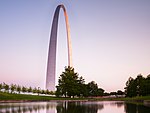
|
| St. Louis Art Museum | Built for the 1904 World's Fair, with a building designed by Cass Gilbert, the museum houses paintings, sculptures, and cultural objects. The museum is located in Forest Park, and admission is free. | 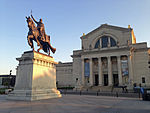
|
| Missouri Botanical Garden | Founded in 1859, the Missouri Botanical Garden is one of the oldest botanical institutions in the United States and a National Historic Landmark. It spans 79 acres in the Shaw neighborhood, including a 14-acre (5.7-hectare) Japanese garden and the Climatron geodesic dome conservatory. | 
|
| Cathedral Basilica of St. Louis | Dedicated in 1914, it is the mother church of the Archdiocese of St. Louis and the seat of its archbishop. The church is known for its large mosaic installation (which is one of the largest in the Western Hemisphere with 41.5 million pieces), burial crypts, and its outdoor sculpture. | 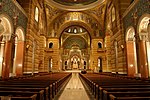
|
| City Hall | Located in Downtown West, City Hall was designed by Harvey Ellis in 1892 in the Renaissance Revival style. It is reminiscent of the Hôtel de Ville, Paris. | 
|
| Central Library | Completed in 1912, the Central Library building was designed by Cass Gilbert. It serves as the main location for the St. Louis Public Library. | 
|
| City Museum | City Museum is a play house museum, consisting largely of repurposed architectural and industrial objects, housed in the former International Shoe building in the Washington Avenue Loft District. | 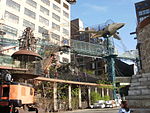
|
| Old Courthouse | Built in the 19th century, it served as a federal and state courthouse. The Scott v. Sandford case (resulting in the Dred Scott decision) was tried at the courthouse in 1846. | 
|
| St. Louis Science Center | Founded in 1963, it includes a science museum and a planetarium, and is situated in Forest Park. Admission is free. It is one of two science centers in the United States which offers free general admission. | 
|
| St. Louis Symphony | Founded in 1880, the St. Louis Symphony Orchestra is the second oldest symphony orchestra in the United States, preceded by the New York Philharmonic. Its principal concert venue is Powell Symphony Hall. | 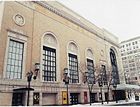
|
| Union Station | Built in 1888, it was the city's main passenger intercity train terminal. Once the world's largest and busiest train station, it was converted in the 1980s into a hotel, shopping center, and entertainment complex. Today, it also continues to serve local rail (MetroLink) transit passengers, with Amtrak service nearby. On December 25, 2019, the St. Louis Aquarium opened inside Union Station. The St. Louis Wheel, a 200 ft 42 gondola ferris wheel, is also located at Union Station. | 
|
| St. Louis Zoo | Built for the 1904 World's Fair, it is recognized as a leading zoo in animal management, research, conservation, and education. It is located in Forest Park, and admission is free. | 
|
Architecture
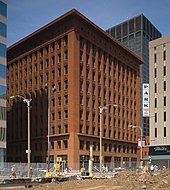
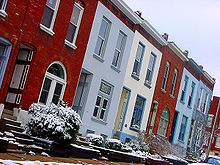
The architecture of St. Louis exhibits a variety of commercial, residential, and monumental architecture. St. Louis is known for the Gateway Arch, the tallest monument constructed in the United States at 630 feet (190 m).[50] The Arch pays homage to Thomas Jefferson and St. Louis's position as the gateway to the West. Architectural influences reflected in the area include French Colonial, German, early American, and modern architectural styles.
Several examples of religious structures are extant from the pre-Civil War period, and most reflect the common residential styles of the time. Among the earliest is the Basilica of St. Louis, King of France (referred to as the Old Cathedral). The Basilica was built between 1831 and 1834 in the Federal style. Other religious buildings from the period include SS. Cyril and Methodius Church (1857) in the Romanesque Revival style and Christ Church Cathedral (completed in 1867, designed in 1859) in the Gothic Revival style.
A few civic buildings were constructed during the early 19th century. The original St. Louis courthouse was built in 1826 and featured a Federal style stone facade with a rounded portico. However, this courthouse was replaced during renovation and expansion of the building in the 1850s. The Old St. Louis County Courthouse (known as the Old Courthouse) was completed in 1864 and was notable for having a cast iron dome and for being the tallest structure in Missouri until 1894. Finally, a customs house was constructed in the Greek Revival style in 1852, but was demolished and replaced in 1873 by the U.S. Customhouse and Post Office.
Because much of the city's commercial and industrial development was centered along the riverfront, many pre-Civil War buildings were demolished during construction of the Gateway Arch. The city's remaining architectural heritage of the era includes a multi-block district of cobblestone streets and brick and cast-iron warehouses called Laclede's Landing. Now popular for its restaurants and nightclubs, the district is located north of Gateway Arch along the riverfront. Other industrial buildings from the era include some portions of the Anheuser-Busch Brewery, which date to the 1860s.
St. Louis saw a vast expansion in variety and number of religious buildings during the late 19th century and early 20th century. The largest and most ornate of these is the Cathedral Basilica of St. Louis, designed by Thomas P. Barnett and constructed between 1907 and 1914 in the Neo-Byzantine style. The St. Louis Cathedral, as it is known, has one of the largest mosaic collections in the world. Another landmark in religious architecture of St. Louis is the St. Stanislaus Kostka, which is an example of the Polish Cathedral style. Among the other major designs of the period were St. Alphonsus Liguori (known as The Rock Church) (1867) in the Gothic Revival and Second Presbyterian Church of St. Louis (1900) in Richardsonian Romanesque.
By the 1900 census, St. Louis was the fourth largest city in the country. In 1904, the city hosted a world's fair at Forest Park called the Louisiana Purchase Exposition. Its architectural legacy is somewhat scattered. Among the fair-related cultural institutions in the park are the St. Louis Art Museum designed by Cass Gilbert, part of the remaining lagoon at the foot of Art Hill, and the Flight Cage at the St. Louis Zoo. The Missouri History Museum was built afterward, with the profit from the fair. But 1904 left other assets to the city, like Theodore Link's 1894 St. Louis Union Station, and an improved Forest Park.
One US Bank Plaza, the local headquarters for US Bancorp, was constructed in 1976 in the structural expressionist style. Several notable postmodern commercial skyscrapers were built downtown in the 1970s and 1980s, including the former AT&T building at 909 Chestnut Street (1986), and One Metropolitan Square (1989), which is the tallest building in St. Louis.
During the 1990s, St. Louis saw the construction of the largest United States courthouse by area, the Thomas F. Eagleton United States Courthouse(2000). The Eagleton Courthouse is home to the United States District Court for the Eastern District of Missouri and the United States Court of Appeals for the Eighth Circuit. The most recent high-rise buildings in St. Louis include two residential towers: One Hundred in the Central West End neighborhood and One Cardinal Way in the Downtown neighborhood.
Neighborhoods

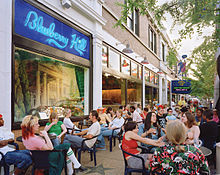
The city is divided into 79 officially-recognized neighborhoods.[51]
Topography
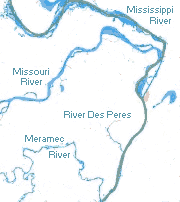
According to the United States Census Bureau, St. Louis has a total area of 66 square miles (170 km2), of which 62 square miles (160 km2) is land and 4.1 square miles (11 km2) (6.2%) is water.[52] The city is built on bluffs and terraces that rise 100–200 feet above the western banks of the Mississippi River, in the Midwestern United States just south of the Missouri-Mississippi confluence. Much of the area is a fertile and gently rolling prairie that features low hills and broad, shallow valleys. Both the Mississippi River and the Missouri River have cut large valleys with wide flood plains.
Limestone and dolomite of the Mississippian epoch underlie the area, and parts of the city are karst in nature. This is particularly true of the area south of downtown, which has numerous sinkholes and caves. Most of the caves in the city have been sealed, but many springs are visible along the riverfront. Coal, brick clay, and millerite ore were once mined in the city. The predominant surface rock, known as St. Louis limestone, is used as dimension stone and rubble for construction.
Near the southern boundary of the city of St. Louis (separating it from St. Louis County) is the River des Peres, practically the only river or stream within the city limits that is not entirely underground.[53] Most of River des Peres was confined to a channel or put underground in the 1920s and early 1930s. The lower section of the river was the site of some of the worst flooding of the Great Flood of 1993.
The city's eastern boundary is the Mississippi River, which separates Missouri from Illinois. The Missouri River forms the northern line of St. Louis County, except for a few areas where the river has changed its course. The Meramec River forms most of its southern line.
Climate

The urban area of St. Louis has a humid subtropical climate (Köppen: Cfa); however, its metropolitan region even to the south may present a hot-summer humid continental climate (Dfa), which shows the effect of the urban heat island in the city. The city experiences hot, humid summers and chilly to cold winters. It is subject to both cold Arctic air and hot, humid tropical air from the Gulf of Mexico. The average annual temperature recorded at nearby Lambert–St. Louis International Airport, is 57.4 °F (14.1 °C). 100 and 0 °F (38 and −18 °C) temperatures can be seen on an average 3 and 1 days per year, respectively. Precipitation averages 41.70 inches (1,100 mm), but has ranged from 20.59 in (523 mm) in 1953 to 61.24 in (1,555 mm) in 2015. The highest recorded temperature in St. Louis was 115 °F (46 °C) on July 14, 1954, and the lowest was −22 °F (−30 °C) on January 5, 1884.
St. Louis experiences thunderstorms 48 days a year on average.[54] Especially in the spring, these storms can often be severe, with high winds, large hail and tornadoes. Lying within the hotbed of Tornado Alley, St. Louis is one of the most frequently tornado-struck metropolitan areas in the U.S. and has an extensive history of damaging tornadoes. Severe flooding, such as the Great Flood of 1993, may occur in spring and summer; the (often rapid) melting of thick snow cover upstream on the Missouri or Mississippi Rivers can contribute to springtime flooding.





